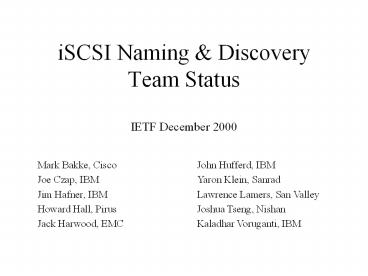iSCSI Naming - PowerPoint PPT Presentation
Title:
iSCSI Naming
Description:
Targets register with or discovered by storage director. Find targets and/or SNS ... Target redirect responses allow a target to be moved to a different address ... – PowerPoint PPT presentation
Number of Views:17
Avg rating:3.0/5.0
Title: iSCSI Naming
1
iSCSI Naming Discovery Team StatusIETF
December 2000
- Mark Bakke, Cisco
- Joe Czap, IBM
- Jim Hafner, IBM
- Howard Hall, Pirus
- Jack Harwood, EMC
John Hufferd, IBM Yaron Klein, Sanrad Lawrence
Lamers, San Valley Joshua Tseng, Nishan Kaladhar
Voruganti, IBM
2
Naming and Addressing Requirements
- Each target or initiator has
- One name - world-wide unique identifier
- One or more addresses paths to find target or
initiator - An address can represent multiple targets
- iSCSI target name or TCP port can multiplex them
- A target may be represented by multiple addresses
- An initiator may use multiple addresses
- LU addressing is covered by SCSI, not iSCSI
3
Target Addressing
- IP Address TCP Port Target Name (URL-like)
- IP Address can serve multiple TCP ports
- IP Address Port can serve multiple target names
- Default canonical port registered with IANA
- Default path is blank, or something like iscsi.
- Each layer has its own address and muxing
- bigarray.ietf.org4000/my_disk_target
4
World-Wide Unique Identifier
- WWUI represents a target or initiator, not a port
- Identical regardless of path
- Used for authentication of targets and initiators
- Should not be tied to interface hardware
- Stable for long periods of time
- Hierarchical format, with naming authority
- Must specify size limit and encoding scheme
5
Discovery Requirements
- Find targets by querying a target address
- Tell me which targets you have that I should
see - Find targets by querying a SNS
- Targets register with or discovered by storage
director - Find targets and/or SNS by multicast
- Scaling requirements
- Small environments do not require SNS
- Large environments use SNS to scale
- Target redirect responses allow a target to be
moved to a different address
6
Work Items / Next Steps
- Name Service interfaces for use by initiators and
targets - Name Service interaction with authentication
- Format of the WWUI
- Naming Authority and local UI
- Character set allowed in WWUI Unicode?
- Recommended UI schemes for naming authorities
- WWUI interaction with authentication and iSCSI
login - Secure interaction between initiators, targets,
and name service































